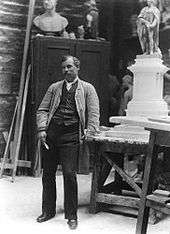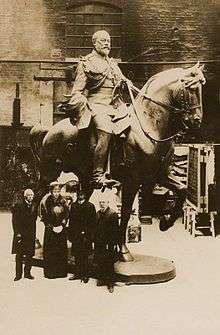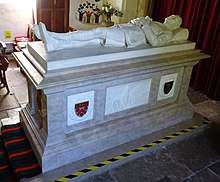Thomas Brock
Sir Thomas Brock KCB RA (1 March 1847 – 22 August 1922)[1] was an English sculptor and medallist, whose works include the Victoria Memorial in front of Buckingham Palace, London. Other commissions included the redesign of the effigy of Queen Victoria for coinage, and the massive bronze equestrian statue of Edward, the Black Prince, in City Square, Leeds.[2]

Life
Brock was born on 1 March 1847 in Worcester, attended the School of Design there, and then undertook an apprenticeship in modelling at the Worcester Royal Porcelain Works. In 1866 he became a pupil of the sculptor John Henry Foley. After Foley's death in 1874, Brock finished some of his commissions. It was his completion of Foley's statue of Prince Albert for the Albert Memorial which first brought Brock to prominence.

His group The Moment of Peril (now in the garden of Leighton House) was followed by The Genius of Poetry, at the Carlsberg Brewery in Copenhagen, Eve (1898),[3] and other imaginative works that mark his development. His portrait works include busts, such as those of Lord Leighton and Queen Victoria, statues, such as Sir Richard Owen and Henry Philpott, bishop of Worcester, and sepulchral monuments such as Lord Leighton (d.1896) in St Paul's Cathedral.
In 1901 Brock was asked to make a colossal equestrian statue of Edward the Black Prince for Leeds City Square, and was also given perhaps his most significant commission, the vast multi-figure Imperial Memorial to Queen Victoria to be set up in front of Buckingham Palace. He had previously made statues of the queen to celebrate her golden and diamond jubilees, and designed the depiction of her "veiled" or "widowed" head, used on all gold, silver and bronze coinage between 1893 and 1901.[4] According to legend, at the unveiling of the memorial in May 1911, George V was so moved by the excellence of the memorial that he called for a sword and knighted Brock on the spot.
Brock was elected an associate of the Royal Academy in 1883 and a full member in 1891.
He died in London on 22 August 1922.
Family
Brock married in 1869, and had eight children. His youngest son was the painter (Charles) Edmond Brock.[5]
Works



- Statue of Richard Baxter, 17th century English Puritan church leader and divine scholar. Originally in the Bull Ring, Kidderminster but moved to its present site, outside St Mary's parish church in March 1967. Unveiled 28 July 1875.[6][7]
- The Black Prince, Leeds City Square, 1901.
- Equestrian bronze A Moment of Peril (1880) now in the collection of Tate Britain.
- Statue of Robert Raikes, Victoria Embankment Garden, London. Erected 1880.[8]
- Statue of Sir Rowland Hill, inventor of the Penny Black and modern postal system. Vicar Street, Kidderminster. Unveiled 26 June 1881.[9][10]
- Statue and bas-relief on the Sir Henry Bartle Frere Memorial, Whitehall Gardens, London (1888).[11]
- Monument to Henry Philpott, Bishop of Worcester. South Transept of Worcester Cathedral. Seated white figure (1892).[12]
- Design of Queen Victoria's "veiled" or "widowed" head on British coinage and medals (1893–1901).
- Queen Victoria Monument, Carlisle. Erected 1902.[13]
- Memorial to William Gladstone. St John's Gardens, Liverpool. Unveiled 1904.
- Statue of Sir John Everett Millais, outside Tate Britain, Millbank, London. Represented standing holding a palette and a paintbrush. Originally erected on the east side of the gallery in 1905; moved to its present position at the rear of the building in 2000.[14]
- Statue of Queen Victoria, Agra, Uttar Pradesh, 1905 (removed after 1947 independence of India)[15]
- Statue of Queen Victoria, Bangalore, India, 1906[16]
- Victoria Memorial, London, unveiled 1911, completed 1924
- Equestrian statue of Edward VII, Macquarie Street, Sydney. Brock was chosen for the commission in 1915, but the work was not finished and delivered until 1921.[17]
- Equestrian statue of Edward VII. Unveiled in New Delhi, India, 1922; it was removed in 1967, sold in 1968 and re-erected in Queen's Park in Toronto, Ontario, Canada in 1969.[18]
- Bust of Henry W. Longfellow, Grand Pre, Nova Scotia.
- Statue of Queen Victoria on the grounds of the Belfast City Hall.
- Memorial to the victims of the sinking of the RMS Titanic, also on the grounds of Belfast City Hall.
- Statue of Sir Henry Irving on Charing Cross Road, London.
- Statue of Captain James Cook, in The Mall, near Admiralty House, London[19]
- Figures of Navigation and Gunnery at the Admiralty Arch, London.
- Bust of Lord Joseph Lister, surgeon. Portland Place, London.
- A statue of Thomas Hughes outside Rugby School Library, unveiled in 1899.[20]
- Effigial monument to Captain Charles Grant Seely (killed in action 1917) in St Olave's Church, Gatcombe, Isle of Wight. Unveiled in 1922, this was Brock's final completed work.[21]
Gallery
 Brock caricatured by Spy for Vanity Fair, 1905
Brock caricatured by Spy for Vanity Fair, 1905 Gilded figure of Albert at the Albert Memorial
Gilded figure of Albert at the Albert Memorial The Black Prince in City Square, Leeds
The Black Prince in City Square, Leeds The Titanic Memorial in Belfast
The Titanic Memorial in Belfast Statue of John Everett Millais outside the Tate Gallery in London
Statue of John Everett Millais outside the Tate Gallery in London Finial figure of Victory, Victoria Memorial
Finial figure of Victory, Victoria Memorial- Victoria, Victoria Memorial, London
 Victoria in Victoria Square, Birmingham
Victoria in Victoria Square, Birmingham Lord Merthyr unveiled in 1913 at Aberdare Park
Lord Merthyr unveiled in 1913 at Aberdare Park
 The Genius of Poetry, Carlsberg Brewery in Copenhagen
The Genius of Poetry, Carlsberg Brewery in Copenhagen Captain C. G. Seely at Gatcombe, Isle of Wight
Captain C. G. Seely at Gatcombe, Isle of Wight Close-up of the Black Prince in City Square, Leeds
Close-up of the Black Prince in City Square, Leeds
References
- "Sir Thomas Brock British sculptor". Encyclopædia Britannica, Inc. Retrieved 15 June 2016.
- "Brock, Sir Thomas". Oxford Dictionary of National Biography. 3 January 2008. Retrieved 5 June 2020.
- A plaster model for Eve was shown at the Royal Academy in 1898; a marble version (1900) is in the collection of the Tate and Brock also some smaller bronze replicas. See "Sir Thomas Brock: Eve, 1900". Tate. Retrieved 3 April 2015.
- "Artist of the Month". Royal Academy of Arts Collections. September 2009. Retrieved 3 April 2015.
- "Artist in focus: Edmond Brock | Art UK". artuk.org. Retrieved 7 May 2018.
- The Buildings of England: Worcestershire, Nikolaus Pevsner, 1968 p207
- Kidderminster Since 1800, Ken Tomkinson and George Hall, 1975, pp. 209–210.
- Gomme 1910, p. 42.
- The Buildings of England: Worcestershire, Nikolaus Pevsner, 1968 p208
- "Sir Rowland Hill (1795-1879)". Thomas Brock. Victorianweb.org. 20 August 2009. Retrieved 7 January 2018.
- Gomme 1910, p. 24.
- The Buildings of England: Worcestershire, Nikolaus Pevsner, 1968, p. 312.
- "Queen Victoria Monument, Carlisle". History and Heritage. Retrieved 3 April 2015.
- "Sir Thomas Brock: Sir John Everett Millais 1904". Tate. Retrieved 3 April 2015.
- "Statue of Queen Victoria | Yale Center For British Art". interactive.britishart.yale.edu. Retrieved 21 April 2018.
- Iyer, Meera (4 February 2013). "Empress of all she surveys" (Bangalore). Deccan Herald. Retrieved 11 January 2016.
- "Royalty and Australian Society Chapter 2: King Edward VII". National Archives of Australia. Retrieved 3 April 2015.
- Wencer, David. "Historicist: Here Comes the Equestrian Statue". Torontoist. Retrieved 4 April 2015.
- "The Mall, London". The Captain Cook Society (CCS). Retrieved 2 February 2019.
- Public sculpture of Warwickshire, Coventry and Solihull by George Thomas Noszlopy, pp. 28–29.
- Harris, Oliver D. (2018). "A crusading 'captain in khaki': Sir Thomas Brock's monument to Charles Grant Seely at Gatcombe (Isle of Wight)". Church Monuments. 33: 97–120.
Bibliography
- Beattie, Susan (1983). The New Sculpture. New Haven: Yale University Press. ISBN 9780300028607.
- Brock, Frederick (2012). Sankey, John (ed.). Thomas Brock: forgotten sculptor of the Victoria Memorial. Bloomington, Ind.: AuthorHouse. ISBN 9781467883344.
- Byron, Arthur (1981). London Statues: a guide to London's outdoor statues and sculpture. London: Constable. ISBN 9780094634305.
- Getsy, David J. (2004). Body Doubles: Sculpture in Britain, 1877–1905. New Haven: Yale University Press. ISBN 9780300105124.
- Gomme, George Laurence (1910). Return of Outdoor Memorials in London. London: London County Council.
- Harrold, Pauline; Rota, Una; Stainton, Thomas, eds. (1968). British Sculpture, 1850–1914: a loan exhibition of sculpture and medals sponsored by the Victorian Society, 30th September–30th October 1968. London: Fine Art Society.
- Read, Benedict (1982). Victorian Sculpture. New Haven: Yale University Press. ISBN 9780300025064.
- Sankey, John Anthony (2002). Thomas Brock and the Critics – An Examination of Brock's Place in the New Sculpture Movement. PhD Thesis: University of Leeds.
- Stocker, Mark. "Brock, Sir Thomas (1847–1922)". Oxford Dictionary of National Biography (online ed.). Oxford University Press. doi:10.1093/ref:odnb/32080. (Subscription or UK public library membership required.)
External links
| Wikimedia Commons has media related to Thomas Brock. |
- Britannica Encyclopedia
- Mapping the Practice and Profession of Sculpture in Britain and Ireland 1851–1951
- Royal Academy of Arts Collections
![]()
| Preceded by Joseph Edgar Boehm |
Coins of the pound sterling Obverse sculptor 1892 |
Succeeded by George William de Saulles |